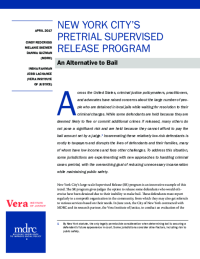New York City’s Pretrial Supervised Release Program
An Alternative to Bail

Across the United States, criminal justice policymakers, practitioners, and advocates have raised concerns about the large number of people who are detained in local jails while waiting for resolution of their criminal charges, because they cannot afford to pay the bail amount set by a judge, even when they pose no significant risk of flight or danger to the community. Incarcerating these relatively low-risk defendants is costly to taxpayers and disrupts the lives of defendants and their families, many of whom have low incomes and face other challenges. To address this situation, some jurisdictions are experimenting with new approaches to handling criminal cases pretrial, with the overarching goal of reducing unnecessary incarceration while maintaining public safety.
New York City’s large-scale Supervised Release program is an innovative example of this trend. The program gives judges the option to release some defendants who would otherwise have been detained due to their inability to make bail. These defendants must report regularly to a nonprofit organization in the community, from which they may also get referrals to various services based on their needs. In 2016, the City of New York contracted with MDRC and its research partner, the Vera Institute of Justice, to conduct an evaluation of the Supervised Release program.
This brief introduces the program and its evaluation and provides some early findings. In the first nine months of operation, about 2,400 defendants across the five boroughs enrolled in the program; participants interviewed expressed appreciation for the opportunity to avoid pretrial jail detention and continue with their lives in the community while fighting their criminal charges. Overall, judges and defense attorneys had positive opinions of Supervised Release, although some defense attorneys favored changes to the program, and prosecutors’ responses were mixed. In practice, the five boroughs showed variations in Supervised Release reflecting their own courtroom cultures; these variations may be important in understanding differences in the program’s impacts, to be explored in future reports.






